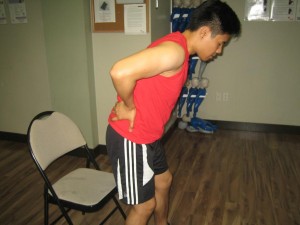Professional athletes and outdoor enthusiasts usually experience back strain as a common injury. Back strain usually occurs if one of the muscles supporting the spine is torn, twisted or pulled. Individuals engaged in sports that involve jumping such as volleyball and basketball are prone to the injury. Those who are overweight or have a history of previous back injuries are vulnerable to back strain.
Individuals who suffer from back strain can easily manage it at home, but it is best to have it checked by a doctor. If it is more than a mild back strain, getting immediate treatment from the professionals can prevent lasting damage.

Symptoms of back strain
- Swelling
- Pain
- Muscle weakness or loss of function
- Muscle cramping or spasms
Always remember that mild back strain can be treated at home but it is best to call a doctor for a back injury that has the following symptoms:
- Pain that interferes with ability to walk or move
- Severe swelling and pain
- Pain that disrupts sleeping
- Numbness in the affected area or down the leg
Steps to take for the initial 48 hours
For the first two days after the injury, the main objective of the first aid care is to minimize pain, swelling and the muscle spasms.
- Rest by limiting your normal activities for a day or more if needed.
- Ice the affected area using an ice pack for 20 minutes at a time, 4-8 times a day. A cold pack or simply fill a bag with ice that is wrapped in towel can be used. Continue the application of ice for 2 days after the injury. It will minimize the inflammation by constricting the blood vessels.
- Medications such as over-the-counter non-steroidal anti-inflammatory drugs such as ibuprofen, aspirin or naproxen can be given for pain relief and to minimize swelling.
Two days after the injury
If the back still hurts, it is best to rest in bed for a week. On the other hand, it is actually better to return to your normal activities as soon as possible. Take note the prolonged rest and immobility will only delay the recovery process.
[youtube url=”http://www.youtube.com/watch?v=TfZMspiFbnM”]After a few days, you can start heat application to the affected area in order to ease the pain by relaxing the tight muscles. You can use a heat lamp, heating pad or a hot compress. The heat helps dilate the blood vessels which increase the flow of blood to the affected area. This helps promote healing since the blood brings in the necessary nutrients and transports away the cell debris from the damaged tissues. In most cases, the symptoms of back strain usually go away within two weeks. If the symptoms last longer, it is best to seek immediate care.
